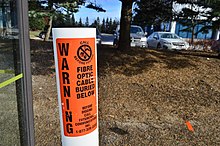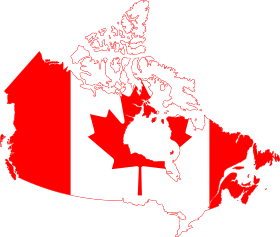Internet in Canada

Canada ranks as the 21st in the world forInternet usagewith 31.77 million users as of July 2016 (est), making up 89.8% of the population.[1]According to Harvard researchers, Canada has some of the lowest internet standards amongOECDcountries, as a result of high costs and slow internet speeds.[2]
Web use[edit]
According to the CIRA 2013 Factbook, Canadians spend more time online than anyone else in the world—an average of 45 hours a month. They also watch more online video, with an average of 300 views per month in 2011.[3]
The most popular websites in Canada are major sites such asGoogle,Facebook,andYouTube.[4]The 17th most popular website,Pornhub,is headquartered inMontreal, Quebec.[5]
The most popular native Canadian websites are the major Canadian news media companies, which maintain an extensive web presence. According to a February 2008 report by comScore, the most popular Canadian sites areQuebecor Media,principallyCanoe.ca,followed closely byCTVglobemediawhich includesglobeandmail.comandCTV.ca.[6]
History[edit]
Canada'sDATAPACwas the world's firstpublic data networkdesigned specifically forX.25when it opened for use in 1976.[7]
A 1983 project to network approximately 20 Canadian universities was initiated and driven at theUniversity of Guelphby a small team including Bob McQueen, Kent Percival and Peter Jaspers-Fayer with the aim to share files and transfer emails. The IBM mainframeRSCSprotocol was originally intended to connect remote printers and card readers to mainframes, but was easily adapted to this new networking use of file sharing and email forwarding. Dedicated telecommunication lines, typically 2400 bits per second, were leased point to point between neighboring universities, with each university paying the cost of one leased line to its nearest neighbor.
The scheme came after the development of theBITNETnetwork in the United States which used the same protocols. An interconnection between the Canadian cluster of universities, called NetNorth, and the larger and quickly growing BITNET network in the US was negotiated and made operational at the startup in 1984. Before the end of the following year, coast-to-coast connectivity to BITNET was in place, 100 years to the day of the last spike being driven on the cross-Canada railroad.[8]Other gateways were developed to interconnect withARPAnet,CSNET,NSFNET(in 1989)[9]and others. The early adopting Canadian universities were soon able to connect to many thousands of computer network nodes in the USA and internationally. This gatewayed international "network of networks" came to be known as theInternet.
File sharing[edit]
In general, the unauthorized copying or distribution of copyrighted material, whether for profit or for personal use, is illegal under Canada'sCopyright Act.[10]However, certain exemptions are made forfair dealingcopying of small portions of copyrighted works, for activities such as private study, criticism, and news reporting. Furthermore, the Act allows that the copying of sound recordings of musical works for the personal use is not copyright infringement. This is supported by alevy on blank recording media,which is distributed to record labels and musicians, although not evenly. While the unauthorized downloading or uploading of complete copyrighted works such as books, movies, or software is illegal under the Act, the situation regarding music files is more complex.
Fibre optic networks[edit]

Multiple providers, includingBell CanadaandRogers Communicationsin Eastern Canada,Telus Internetin BC and Alberta, andSaskTelin Saskatchewan have made investments into upgrading their infrastructure to providelast milefibreopticconnectivity, orfibre to the home(FTTH).[11][12][13]In December 2016, local companyMNSi Telecomannounced a $35 million fibre build inWindsor, Ontario.[14]
In July 2015, the CRTC ruled that major telecoms providing fibre to the home must allow smaller providers to purchase wholesale access to their networks. Bell Canada attempted to oppose the ruling, but failed.[15]
Comparison[edit]
Regional CanadianISPspeer through a few majorInternet exchange points,the most notable of which is theToronto Internet Exchange.However, these regional networks usually share the same backbones for longer distance connectivity.
The largest DSL provider in Canada is Bell Internet (formerly Bell Sympatico). Bell owns and maintains physical layer connectivity through a combination of optical fibre networks,DSLAMand Customer Premises Equipment. InBritish Columbia(BC),Alberta(AB), and parts ofQuebec(QC), the incumbent telco is Telus, owning the DSLAMs and fibre, providing many of the same services Bell does.
The other major players offering DSL and IPTV services areSaskTelin Saskatchewan andManitoba Telecom Services(MTS) inManitoba.Download speeds are up to 25 Mbit/s for average users, though recent upgrades now make HDTV and much higher rates possible.[citation needed]
For cable offerings, standard North AmericanDOCSISbased equipment are used. The largest cable internet providers in Canada are Shaw Communications (Western) and Rogers Cable (Eastern) offering internet speeds of up to 1000 Mbit/s.
Usage-based billing[edit]
Internet bandwidth limits and caps are considered by many to be too restrictive, due to the increasing popularity of onlinestreaming mediaservices such asNetflix,which require large amounts of bandwidth.[16]
The decision to impose bandwidth caps on smaller independent ISPs[17]caused controversy in 2011 when theCanadian Radio-television and Telecommunications Commission(CRTC), Canada's telecommunications regulator, approved a request byBell Internetto begin, on March 1, 2011, to apply a bandwidth cap on the users of smaller independent ISPs who use Bell'slast mileinfrastructure. This new billing structure is called "usage-based billing" or UBB.
Bell pushed for a cap as small as 25 gigabytes of transfer per month, plus a $1–2CADsurcharge for every GB over the limit. The stated intent was to prevent the customers of independent ISPs from congesting Bell's network,[18]because many independent ISPs offer service with unlimited bandwidth, while most major Canadian ISPs do not. The CRTC was criticized for allowing Bell to useanti-competitivepractices to favour its own Internet and television offerings.[19]Bell is also under fire for forcing its own pricing structure and business on its wholesalers. Bell admits that more than 10 percent of its subscribers (at the time of said download cap) exceed their limit, resulting in additional billing.[20]
Many savvy Internet users also accuse Bell of falsifying information to the public regardingnetwork congestion.Network congestion is primarily caused by many users accessing the Internet at the same time (after school/work, 5pm–10pm) and not byheavy usersalone. Similar criticism was levied whenEastlink Rural Connectapplied UBB in July 2015, which many users reported made peak time congestion worse.SeeBroadband for Rural Nova Scotia initiativefor this and related wireless broadband congestion problems.
On February 2, 2011, industry ministerTony ClementandPrime MinisterStephen Harpercalled on the CRTC to reverse the decision. The next day, the CRTC announced that it would delay its decision by 60 days.[21]
There are some supporters for usage-based-billing (UBB) at lower rates instead of the current $2/GB. One example isTekSavvy,providing "Lite" cable Internet services (6 Mbit/s down, ¼ Mbit/s up) at $30.95/month with 300 GB, equivalent to around 10¢/GB.[22]Rogers Hi-Speed Internetoffers Internet access at the same speed for $41.49/month but with only 20 GB, equivalent to around $2.07/GB.[23]The difference of $1.97/GB between the two providers is one key reason why consumer advocates oppose UBB. Some also claim that it costs the incumbents as low as 3¢/GB.[24]
Supporters also suggest that instead of a penalty-based system (heavy userspay more), a credit-based system (light users be credited back monthly) would be much more consumer friendly and fair.
Digital divide[edit]

Thedigital divide in Canadarefers to the discrepancy that exists between Canadians who have access toinformation and communication technologies(ICT) and the benefits they provide compared to those who do not.[25]This divide can be the result of many factors, including high costs for technology and online access,[26]differences in the availability of online connectivity resources in different locations across the country,[27]and lackingdigital literacy.The digital divide inCanadaalso stems fromincome inequalityamong Canadians and differences in online practices exhibited by those of different age, gender, first language, and cultural background.[28]
The digital divide is greatest in Northern Canada due to the economic and geographical obstacles to setting up high speed internet connections between distant and sparsely populated towns, along with some residents' low digital literacy rates and lack of access to technology.[29]
Various government initiatives are currently being implemented to reduce the digital divide in Canada, including plans aimed at providing all Canadians with affordable high speed internet packages,[30]increasing the amount of free publicWi-Fiavailable,[31]and the improvement of digital literacy among students in public elementary and high schools.[32]See also[edit]
- List of internet service providers in Canada
- List of Canadian mobile phone companies
- Censorship in Canada § Internet
- Science and technology in Canada
- Social networking in Canada
- Demographics of the Canadian political blogosphere
- Broadband for Rural Nova Scotia initiative
- CANARIE– national research and education network
- Canadian Internet Registration Authority– Canada'stop-level domainregistrar in charge of.ca
References[edit]
- ^"The World Factbook".www.cia.gov.RetrievedMay 23,2016.
- ^Nowak, Peter (2010)."Canadian internet slow, expensive: Harvard".CBC News.RetrievedMarch 6,2013.
- ^"CIRA Factbook 2013".Canadian Internet Registration Authority.RetrievedJanuary 23,2013.
- ^Alexa.comTop Sites in CanadaArchivedJuly 6, 2020, at theWayback MachineRetrieved April 21, 2013
- ^"Montreal-based Pornhub reveals our porn habits with Big Data".Canadian Business – Your Source For Business News.January 24, 2014.RetrievedNovember 8,2017.
- ^comScore.ArchivedJuly 24, 2012, at theWayback MachineTop Canadian Websites – 2008Retrieved April 21, 2013
- ^Rybczynski, Tony (2009)."Commercialization of packet switching (1975–1985): A Canadian perspective [History of Communications]".IEEE Communications Magazine.47(12): 26–31.doi:10.1109/MCOM.2009.5350364.ISSN1558-1896.S2CID23243636.
- ^Zakon, Robert (November 1997).RFC 2235.IETF.p. 6.doi:10.17487/RFC2235.RetrievedDecember 2,2020.
- ^Zakon, Robert (November 1997).RFC 2235.IETF.p. 8.doi:10.17487/RFC2235.RetrievedDecember 2,2020.
- ^"Copyright Act of Canada".Department of Justice: Canada. November 5, 2007. Archived fromthe originalon June 5, 2011.RetrievedNovember 16,2007.
- ^"Super-fast Internet is coming – along with super-high pricing".The Globe and Mail.RetrievedDecember 22,2016.
- ^"Fibre optic cable battle: Smaller players want in on Big 3 networks".CBC News.RetrievedDecember 22,2016.
- ^"Why sasktel internet".SaskTel.RetrievedMay 31,2018.
- ^Roseann Danese,"MNSi Spending Millions on High Speed Internet",Windsor Star,November 30, 2016
- ^"CRTC to implement wholesale access to ultra fast fibre networks".Financial Post.RetrievedDecember 22,2016.
- ^Lasar, Matthew."200GB to 25GB: Canada gets first, bitter dose of metered Internet".Ars Technica.RetrievedFebruary 3,2011.
- ^"CRTC decision 2011–44 on usage-based billing (UBB)".Toronto Free-Net. Archived fromthe originalon September 29, 2020.RetrievedMay 8,2011.
- ^"CRTC decision 2011–44 on usage-based billing (UBB)".Toronto Free-Net. Archived fromthe originalon September 29, 2020.RetrievedMay 8,2011.
- ^Marlow, Iain (October 29, 2010)."CRTC ruling handcuffs competitive market: TekSavvy".Globe and Mail.Toronto.RetrievedFebruary 3,2011.
- ^Geist, Michael (February 6, 2011)."Geist: The real reason we pay so much for Internet".The Star.Toronto.
- ^"CRTC to review usage-based billing decision".CBC. February 3, 2011.RetrievedFebruary 3,2011.
- ^"Affordable Internet".TekSavvy.RetrievedDecember 30,2012.
- ^Rogers Communications,(2013),Compare Packages,retrieved December 30, 2012
- ^Thompson, Hugh (February 1, 2011)."What is a fair price for Internet service?".Globe and Mail.Toronto.
- ^Sciadas, George (2001)."The Digital Divide in Canada"(PDF).Statistics Canada.RetrievedNovember 24,2016.
- ^Rajabiun, Reza; Ellis, David; Middleton, Catherine (March 2016).Literature Review: Affordability of Communications Services(PDF)(Report).RetrievedNovember 14,2016.
- ^CRTC (2015)."Communications Monitoring Report 2015: Canada's Communications System: An Overview for Citizens, Consumers, and Creators".Government of Canada CRTC.RetrievedOctober 17,2016.
- ^Haight, Michael; Quan-Haase, Anabel; Corbett, Bradley A (2014).Revisiting the digital divide in Canada: the impact of demographic factors on access to the internet, level of online activity, and social networking site usage(Report). Information, Communication & Society.RetrievedNovember 19,2016.
- ^Canada's Public Policy Forum (June 2014).Northern connections: Broadband and Canada's digital divide: final report(PDF)(Report). Ottawa, Ontario. Archived fromthe original(PDF)on August 6, 2016.RetrievedOctober 17,2016.
{{cite report}}:|last=has generic name (help) - ^Government of Canada (2016)."About Connecting Canadians".Digital Canada 150.RetrievedOctober 17,2016.
- ^CBC News (June 14, 2016)."Toronto public libraries, Google to offer free take-home WiFi".RetrievedNovember 20,2016.
- ^Government of Canada (2010)."Digital Literacy in Canada: From Inclusion to Transformation".Digital Canada 150.RetrievedNovember 18,2016.
External links[edit]
- DSL Reports– Extensive site on broadband with user reports from around the USA and Canada
